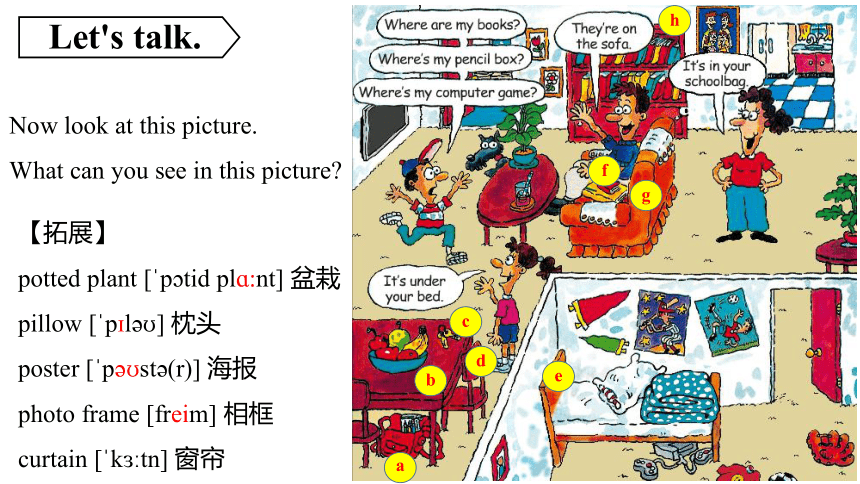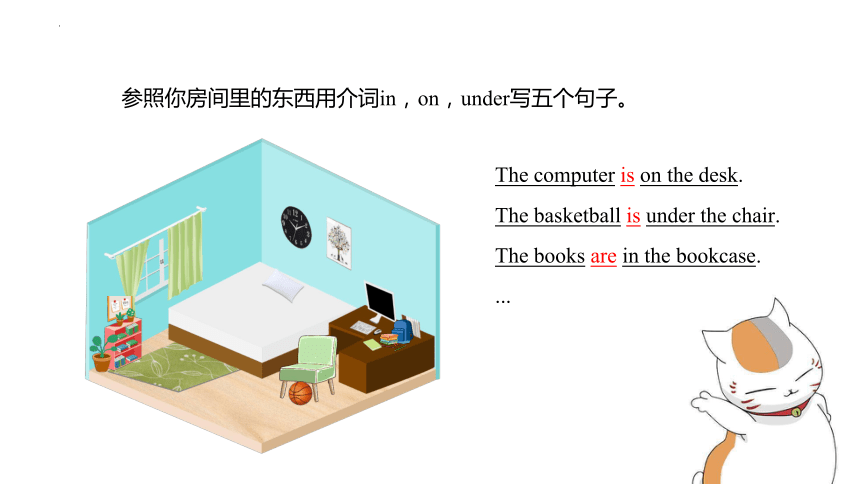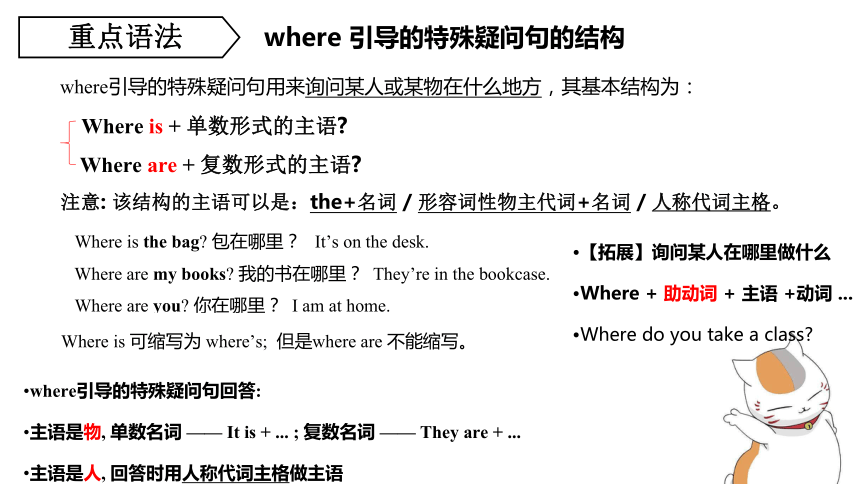Unit 4''Where's my schoolbag 复习课件(共21张PPT) 2023-2024学年人教版英语七年级上册
文档属性
| 名称 | Unit 4''Where's my schoolbag 复习课件(共21张PPT) 2023-2024学年人教版英语七年级上册 |  | |
| 格式 | pptx | ||
| 文件大小 | 1.6MB | ||
| 资源类型 | 教案 | ||
| 版本资源 | 人教新目标(Go for it)版 | ||
| 科目 | 英语 | ||
| 更新时间 | 2023-12-11 21:09:18 | ||
图片预览









文档简介
(共21张PPT)
人教版英语七年级上册课件
Unit 4
Where's my schoolbag
我的书包在哪里?
询问物品位置/方向
重点词汇
所有格's/'用法
含be动词一般疑问句及回答与指示代词提问时的区别
help/ a set of/ what about用法
...的,+- 名词, 共同拥有/各自拥有
Be+主语+....?yes,../No,..
Let’s review
Learning goals
1. Curriculum words: where, table, bed, bookcase, sofa, chair, on, under,
come, desk, think, room, their, hat, head
4. Sentences: —Where are my books —They’re on the sofa.
—Where’s the map —I think it’s in your grandparents’ room.
—Where's my computer game —It’s under your bed.
—Are they in the bookcase —No, they aren’t.
2. Functions: 能够询问并描述物品位置
3. Grammar: 方位介词on, in, under;where引导的特殊疑问句
...在哪里?
Furniture
[ f n t (r)] 家具
bookcase [ b kke s]
bed [bed]
bad [b d]
sofa
[ s f ]
chair [t er]
desk [desk]
table [ te bl]
Now look at this picture.
What can you see in this picture
a
b
c
d
e
f
g
h
Let's talk.
【拓展】
potted plant [ p tid plɑ:nt] 盆栽
pillow [ p l ] 枕头
poster [ p st (r)] 海报
photo frame [freim] 相框
curtain [ k tn] 窗帘
参照你房间里的东西用介词in,on,under写五个句子。
The computer is on the desk.
The basketball is under the chair.
The books are in the bookcase.
...
Mom: Come on, Jack!
Jack: Oh, no! Where’s my bag
Mom: Hmm … is it on your desk
Jack: No. And it’s not under the chair.
Mom: Oh! It’s on the sofa.
Jack: Thank you, Mom. Err … where’s the map
Mom: I think it’s in your grandparents’ room.
Jack: Yes, it’s on their bed! And my hat
Mom: It’s on your head!
Jack: Oh, yeah! Haha!
祖父母的房间
复数名词grandparents
加“ ’ ”变名词所有格
n.书桌
快点儿
n.帽子
n.头
Let's read.
Where are my books 我的书在哪里? They’re in the bookcase.
where引导的特殊疑问句用来询问某人或某物在什么地方,其基本结构为:
Where is the bag 包在哪里? It’s on the desk.
Where are you 你在哪里? I am at home.
where 引导的特殊疑问句的结构
Where are + 复数形式的主语
注意: 该结构的主语可以是:the+名词 / 形容词性物主代词+名词 / 人称代词主格。
Where is + 单数形式的主语
Where is 可缩写为 where’s; 但是where are 不能缩写。
where引导的特殊疑问句回答:
主语是物, 单数名词 —— It is + ... ; 复数名词 —— They are + ...
主语是人, 回答时用人称代词主格做主语
重点语法
【拓展】询问某人在哪里做什么
Where + 助动词 + 主语 +动词 ...
Where do you take a class
在……里面
在……上面
在……下面
It's the box.
It's the box.
It's the box.
Where's the cat?
方位介词
where’s = where is
in
on
under
方位介词
[辨析]在...上面
above 不接触表面, 任意上方
over 不接触表面, 正上方
[辨析]在...下面
below 不接触表面, 任意下方
[拓展]其他方位介词
behind 在...后面
in front of 在...前面
between 在两者之间
among 在三者之间
near/ next to/ beside
在...附近/旁边
方位介词on, in 与 under的用法
on 在……上 一个物体在另一个物体的表面上, 且两个物体之间有接触。
in 在……里 一个物体在另一个物体或某一空间的内部。
under 在……下面 一个物体在另一个物体的正下方, 两者可接触可不接触。
My watch is on the table. 我的手表在桌子上。
They are in the room. 他们在房间里。
The basketball is under the chair. 篮球在椅子下面。
on the wall 在墙上(表面), 如图画/黑板/风筝
in the wall 在墙上(里面), 如门窗/钉子/洞/孔
on the tree 在树上(从树上生长起来的), 如苹果 There is an apple on the tree. 树上有个苹果。
in the tree 在树上(外来的事物), 如鸟 The bird is in the tree. 有只鸟在树上。
【辨析】on/in
on the bed 在床上
in bed 卧床, 睡觉
There are some apples ___ the tree.
有一些苹果在树上。
There are some birds ___ the tree.
There are some leaves ____ the tree.
叶子 leaf
on
in
on
She is ill ____ ____. 她卧病在床
in
bed
[拓展]固定搭配
on earth 究竟,到底,在世界上
on purpose 故意,有意,成心地
on duty 值日,上班
focus on 集中于
[拓展]表时间辨析
in + 月份/ 年份/季节/天 (某段时间内)
in May 5月
in the fall 在秋天
in spring/summer/autumn/winter
在春 / 夏 / 秋 / 冬天
in the morning/afternoon/evening
在上午 / 下午 / 晚上
on + 某一天
on Sunday
at + 时刻/时间
at 2 o'clock
at dawn[d n] 在黎明
at the weekend 周末
at the age of 16 在16岁时
1. Hmm… is it on your desk
desk n.书桌
Point
易混辨析: table与desk
两者都是可数名词,具体区别如下:
table 意为“桌子, 圆桌”,指那些供用餐、开会或娱乐消遣所用的桌子。
desk 意为“书桌”,指供读书、写字、办公所用的桌子。常带有抽屉drawer
Clean the table after lunch. 午饭后清理桌子。
The books are on the desk. 这些书在书桌上。
table 桌子
desk 书桌
重点词汇
【短语】
at the table 在桌子旁
at table 在吃饭/就餐
He is at the table now. 他现在在桌子旁。
He is at table now. 他现在吃饭。
【拓展】
table n.表, 目录
a table of ... ...的目录
There is a table of contents
in the front of a dictionary.
2. Come on, Jack!
come on 快点儿
Point 2
come是不及物动词,其反义词为go,意为“去”。come常与介词to搭配使用, 后面跟地点名词,表示“来到某地”。当come后跟here, home等地点副词时,其后不带介词to。 come on在此处表示催促, 意为“快点儿”。英语中还可以用“Hurry up!”表示催促。
come on的其他用法:
表示安慰 Come on. Don’t cry any more. 振作起来,不要再哭了。
表示鼓励 Come on, Kate. Don’t be shy. 来吧,凯特。别害羞。
招呼他人 Come on! This way, please. 来吧!这边请。
得了吧 Come on, tell the truth. 得了吧,说实话吧。
The train comes to the station. 火车进站了。
My mother always comes home at 6:00. 我妈妈总是在6点回到家。
come up with... 提出, 想到(想法, 建议)
come ture 实现, 成真
come out 结果是, 出版, 出现
Come back to + n. 回到...
3. I think it’s in your grandparents’ room.
常用短语有:
think about 认为, 思考, 考虑到
think of 想起, 认为…(怎么样)
think much/highly of 重视
think nothing/little of 轻视, 忽视
think well of 器重
think up 想出(方法)
I think you are right. 我认为你是对的。
think v. 认为; 想;思考
Point
What do you think of/about the song 你认为这首歌怎么样?
主语
谓语动词
宾语从句(整个句子作宾语)
I can’t think of the name of that man. 我想不起那个人的名字。
I think (that) ... 我认为/觉得...
I don't think (that) ... 我不认为/不觉得...(否定前移)
He thinks she is beautiful. 他觉得她很漂亮。
He doesn’t think she is beautiful. 他觉得她不漂亮。
I think (that) she is a good student. 我认为她是一个好学生。
I don’t think (that) she is a good student.
我认为她不是一个好学生。
4. Uh, I don’t know. 呃, 我不知道
1) Vt. know + 名词/ 代词/ 句子作宾语
2) Vi. Who knows 谁知道
know v. 知道, 了解
Point
I know you well. 我很了解你。
How could I know 我怎么知道呢?
Who knows, perhaps they don’t wish to come.
谁知道呢, 也许他们不愿来呢。
表示不知道的其他用法:
I’m not sure.
I have no idea.
I haven’t got a clue.
5. I'm Kate, and my sister is Gina. / I'm tidy, but Gina is not.
【易混辨析】并列连词 but, and 与 or
and/ but/ or
Point
but 表示转折的逻辑关系或两种情况的对比,意为“但是; 然而”。
and 连接两个或几个并列的成分,常用于肯定句,意为“和; 而”。and 连接的并列成分作主语时,谓语动词用复数形式。
or 在否定句中,连接并列成分要用 or 而不用 and,意为“也不”;or 表示选择关系时,常用于选择疑问句,意为“或, 还是”。
I like apples but I don't like oranges. 我喜欢苹果但不喜欢桔子。
Tom and Cindy are good friends. 汤姆和辛迪是好朋友。
She can't draw or write. 她不会画,也不会写。
Is he a teacher or a doctor 他是老师还是医生?
tidy adj.整洁的,井井有条的
Point
(1)adj. (untidy 凌乱的)
常见用法:
a tidy+ n. 一个整洁的…
a tidy bedroom/desk 一个整洁的卧室/书桌
be tidy 整洁的
My parents and I are tidy. 我爸妈和我都爱干净。
keep tidy 保持整洁
Keep your room tidy. 保持你的房间整洁。
(2) V. 使整洁;使整齐 ;使有条理;整理 (tidy up sth.收拾整理妥)
I spent all morning cleaning and tidying.
我用了整个上午的时间清扫整理。
6. Gina's books are everywhere... 到处都是吉娜的书
由“every(每个)+where(在哪里)”构成,相当于 here and there,其前不能使用in, at, to之类的介词。用于否定句时表示部分否定。
My grandpa takes his dog everywhere. 我爷爷到哪儿都带着他的狗。
We can't find the animal everywhere. 这种动物并不是到处可见。
everywhere adv. 处处; 到处; 各个地方
Point
【拓展延伸】where构成的其他常见词 (here/there):
somewhere 某处/地, 多用于肯定句
anywhere 任何地方, 多用于否定句&疑问句中
nowhere 无处,没有地方, 多用于否定句
The students are everywhere after class. 下课后, 学生到处都是。
I can't go anywhere.
我哪都去不了。
There is nowhere I can go.
我没有地方可去。
7. ...Gina always asks.
1) always 作副词, 常用于一般现在时, 在句中作状语, 表示频率。
2) always与be动词连用时, 放在be动词之后; 与行为动词连用时, 放在行为动词之前。
Paul is always brave. 保罗总是很勇敢。
always adv. 总是, 一直, 始终
Point
(always 放在 be 动词后)
She always wears a white shirt. 她总是穿一件白色衬衫。
(always 放在行为动词前)
Jim always gets up early. 吉姆起床一直很早。
常见的表示频度的副词:
usually 通常
often 经常
sometimes 有时
ever 曾经
never 从不
[练习]
他总是向我要求帮助。
He me for help.
汤姆从不迟到。
Tom is late.
【To introduce your home/room】
I am a girl. My name is Lucy. I have a room at home and I am very tidy. In my room, my books are in the bookcase. My dictionary and books are on the desk. The pencil box is in the schoolbag. The pens and rulers are in the pencil box. I love my room.
Talk
人教版英语七年级上册课件
Unit 4
Where's my schoolbag
我的书包在哪里?
询问物品位置/方向
重点词汇
所有格's/'用法
含be动词一般疑问句及回答与指示代词提问时的区别
help/ a set of/ what about用法
...的,+- 名词, 共同拥有/各自拥有
Be+主语+....?yes,../No,..
Let’s review
Learning goals
1. Curriculum words: where, table, bed, bookcase, sofa, chair, on, under,
come, desk, think, room, their, hat, head
4. Sentences: —Where are my books —They’re on the sofa.
—Where’s the map —I think it’s in your grandparents’ room.
—Where's my computer game —It’s under your bed.
—Are they in the bookcase —No, they aren’t.
2. Functions: 能够询问并描述物品位置
3. Grammar: 方位介词on, in, under;where引导的特殊疑问句
...在哪里?
Furniture
[ f n t (r)] 家具
bookcase [ b kke s]
bed [bed]
bad [b d]
sofa
[ s f ]
chair [t er]
desk [desk]
table [ te bl]
Now look at this picture.
What can you see in this picture
a
b
c
d
e
f
g
h
Let's talk.
【拓展】
potted plant [ p tid plɑ:nt] 盆栽
pillow [ p l ] 枕头
poster [ p st (r)] 海报
photo frame [freim] 相框
curtain [ k tn] 窗帘
参照你房间里的东西用介词in,on,under写五个句子。
The computer is on the desk.
The basketball is under the chair.
The books are in the bookcase.
...
Mom: Come on, Jack!
Jack: Oh, no! Where’s my bag
Mom: Hmm … is it on your desk
Jack: No. And it’s not under the chair.
Mom: Oh! It’s on the sofa.
Jack: Thank you, Mom. Err … where’s the map
Mom: I think it’s in your grandparents’ room.
Jack: Yes, it’s on their bed! And my hat
Mom: It’s on your head!
Jack: Oh, yeah! Haha!
祖父母的房间
复数名词grandparents
加“ ’ ”变名词所有格
n.书桌
快点儿
n.帽子
n.头
Let's read.
Where are my books 我的书在哪里? They’re in the bookcase.
where引导的特殊疑问句用来询问某人或某物在什么地方,其基本结构为:
Where is the bag 包在哪里? It’s on the desk.
Where are you 你在哪里? I am at home.
where 引导的特殊疑问句的结构
Where are + 复数形式的主语
注意: 该结构的主语可以是:the+名词 / 形容词性物主代词+名词 / 人称代词主格。
Where is + 单数形式的主语
Where is 可缩写为 where’s; 但是where are 不能缩写。
where引导的特殊疑问句回答:
主语是物, 单数名词 —— It is + ... ; 复数名词 —— They are + ...
主语是人, 回答时用人称代词主格做主语
重点语法
【拓展】询问某人在哪里做什么
Where + 助动词 + 主语 +动词 ...
Where do you take a class
在……里面
在……上面
在……下面
It's the box.
It's the box.
It's the box.
Where's the cat?
方位介词
where’s = where is
in
on
under
方位介词
[辨析]在...上面
above 不接触表面, 任意上方
over 不接触表面, 正上方
[辨析]在...下面
below 不接触表面, 任意下方
[拓展]其他方位介词
behind 在...后面
in front of 在...前面
between 在两者之间
among 在三者之间
near/ next to/ beside
在...附近/旁边
方位介词on, in 与 under的用法
on 在……上 一个物体在另一个物体的表面上, 且两个物体之间有接触。
in 在……里 一个物体在另一个物体或某一空间的内部。
under 在……下面 一个物体在另一个物体的正下方, 两者可接触可不接触。
My watch is on the table. 我的手表在桌子上。
They are in the room. 他们在房间里。
The basketball is under the chair. 篮球在椅子下面。
on the wall 在墙上(表面), 如图画/黑板/风筝
in the wall 在墙上(里面), 如门窗/钉子/洞/孔
on the tree 在树上(从树上生长起来的), 如苹果 There is an apple on the tree. 树上有个苹果。
in the tree 在树上(外来的事物), 如鸟 The bird is in the tree. 有只鸟在树上。
【辨析】on/in
on the bed 在床上
in bed 卧床, 睡觉
There are some apples ___ the tree.
有一些苹果在树上。
There are some birds ___ the tree.
There are some leaves ____ the tree.
叶子 leaf
on
in
on
She is ill ____ ____. 她卧病在床
in
bed
[拓展]固定搭配
on earth 究竟,到底,在世界上
on purpose 故意,有意,成心地
on duty 值日,上班
focus on 集中于
[拓展]表时间辨析
in + 月份/ 年份/季节/天 (某段时间内)
in May 5月
in the fall 在秋天
in spring/summer/autumn/winter
在春 / 夏 / 秋 / 冬天
in the morning/afternoon/evening
在上午 / 下午 / 晚上
on + 某一天
on Sunday
at + 时刻/时间
at 2 o'clock
at dawn[d n] 在黎明
at the weekend 周末
at the age of 16 在16岁时
1. Hmm… is it on your desk
desk n.书桌
Point
易混辨析: table与desk
两者都是可数名词,具体区别如下:
table 意为“桌子, 圆桌”,指那些供用餐、开会或娱乐消遣所用的桌子。
desk 意为“书桌”,指供读书、写字、办公所用的桌子。常带有抽屉drawer
Clean the table after lunch. 午饭后清理桌子。
The books are on the desk. 这些书在书桌上。
table 桌子
desk 书桌
重点词汇
【短语】
at the table 在桌子旁
at table 在吃饭/就餐
He is at the table now. 他现在在桌子旁。
He is at table now. 他现在吃饭。
【拓展】
table n.表, 目录
a table of ... ...的目录
There is a table of contents
in the front of a dictionary.
2. Come on, Jack!
come on 快点儿
Point 2
come是不及物动词,其反义词为go,意为“去”。come常与介词to搭配使用, 后面跟地点名词,表示“来到某地”。当come后跟here, home等地点副词时,其后不带介词to。 come on在此处表示催促, 意为“快点儿”。英语中还可以用“Hurry up!”表示催促。
come on的其他用法:
表示安慰 Come on. Don’t cry any more. 振作起来,不要再哭了。
表示鼓励 Come on, Kate. Don’t be shy. 来吧,凯特。别害羞。
招呼他人 Come on! This way, please. 来吧!这边请。
得了吧 Come on, tell the truth. 得了吧,说实话吧。
The train comes to the station. 火车进站了。
My mother always comes home at 6:00. 我妈妈总是在6点回到家。
come up with... 提出, 想到(想法, 建议)
come ture 实现, 成真
come out 结果是, 出版, 出现
Come back to + n. 回到...
3. I think it’s in your grandparents’ room.
常用短语有:
think about 认为, 思考, 考虑到
think of 想起, 认为…(怎么样)
think much/highly of 重视
think nothing/little of 轻视, 忽视
think well of 器重
think up 想出(方法)
I think you are right. 我认为你是对的。
think v. 认为; 想;思考
Point
What do you think of/about the song 你认为这首歌怎么样?
主语
谓语动词
宾语从句(整个句子作宾语)
I can’t think of the name of that man. 我想不起那个人的名字。
I think (that) ... 我认为/觉得...
I don't think (that) ... 我不认为/不觉得...(否定前移)
He thinks she is beautiful. 他觉得她很漂亮。
He doesn’t think she is beautiful. 他觉得她不漂亮。
I think (that) she is a good student. 我认为她是一个好学生。
I don’t think (that) she is a good student.
我认为她不是一个好学生。
4. Uh, I don’t know. 呃, 我不知道
1) Vt. know + 名词/ 代词/ 句子作宾语
2) Vi. Who knows 谁知道
know v. 知道, 了解
Point
I know you well. 我很了解你。
How could I know 我怎么知道呢?
Who knows, perhaps they don’t wish to come.
谁知道呢, 也许他们不愿来呢。
表示不知道的其他用法:
I’m not sure.
I have no idea.
I haven’t got a clue.
5. I'm Kate, and my sister is Gina. / I'm tidy, but Gina is not.
【易混辨析】并列连词 but, and 与 or
and/ but/ or
Point
but 表示转折的逻辑关系或两种情况的对比,意为“但是; 然而”。
and 连接两个或几个并列的成分,常用于肯定句,意为“和; 而”。and 连接的并列成分作主语时,谓语动词用复数形式。
or 在否定句中,连接并列成分要用 or 而不用 and,意为“也不”;or 表示选择关系时,常用于选择疑问句,意为“或, 还是”。
I like apples but I don't like oranges. 我喜欢苹果但不喜欢桔子。
Tom and Cindy are good friends. 汤姆和辛迪是好朋友。
She can't draw or write. 她不会画,也不会写。
Is he a teacher or a doctor 他是老师还是医生?
tidy adj.整洁的,井井有条的
Point
(1)adj. (untidy 凌乱的)
常见用法:
a tidy+ n. 一个整洁的…
a tidy bedroom/desk 一个整洁的卧室/书桌
be tidy 整洁的
My parents and I are tidy. 我爸妈和我都爱干净。
keep tidy 保持整洁
Keep your room tidy. 保持你的房间整洁。
(2) V. 使整洁;使整齐 ;使有条理;整理 (tidy up sth.收拾整理妥)
I spent all morning cleaning and tidying.
我用了整个上午的时间清扫整理。
6. Gina's books are everywhere... 到处都是吉娜的书
由“every(每个)+where(在哪里)”构成,相当于 here and there,其前不能使用in, at, to之类的介词。用于否定句时表示部分否定。
My grandpa takes his dog everywhere. 我爷爷到哪儿都带着他的狗。
We can't find the animal everywhere. 这种动物并不是到处可见。
everywhere adv. 处处; 到处; 各个地方
Point
【拓展延伸】where构成的其他常见词 (here/there):
somewhere 某处/地, 多用于肯定句
anywhere 任何地方, 多用于否定句&疑问句中
nowhere 无处,没有地方, 多用于否定句
The students are everywhere after class. 下课后, 学生到处都是。
I can't go anywhere.
我哪都去不了。
There is nowhere I can go.
我没有地方可去。
7. ...Gina always asks.
1) always 作副词, 常用于一般现在时, 在句中作状语, 表示频率。
2) always与be动词连用时, 放在be动词之后; 与行为动词连用时, 放在行为动词之前。
Paul is always brave. 保罗总是很勇敢。
always adv. 总是, 一直, 始终
Point
(always 放在 be 动词后)
She always wears a white shirt. 她总是穿一件白色衬衫。
(always 放在行为动词前)
Jim always gets up early. 吉姆起床一直很早。
常见的表示频度的副词:
usually 通常
often 经常
sometimes 有时
ever 曾经
never 从不
[练习]
他总是向我要求帮助。
He me for help.
汤姆从不迟到。
Tom is late.
【To introduce your home/room】
I am a girl. My name is Lucy. I have a room at home and I am very tidy. In my room, my books are in the bookcase. My dictionary and books are on the desk. The pencil box is in the schoolbag. The pens and rulers are in the pencil box. I love my room.
Talk
同课章节目录
- starters 预备篇(2012秋审查)
- Unit 1 Good morning !
- Unit 2 What’s this in English?
- Unit 3 What color is it ?
- Unit 1 My name's Gina.
- Section A
- Section B
- Unit 2 This is my sister.
- Section A
- Section B
- Unit 3 Is this your pencil?
- Section A
- Section B
- Unit 4 Where's my schoolbag?
- Section A
- Section B
- Unit 5 Do you have a soccer ball?
- Section A
- Section B
- Unit 6 Do you like bananas?
- Section A
- Section B
- Unit 7 How much are these socks?
- Section A
- Section B
- Unit 8 When is your birthday?
- Section A
- Section B
- Unit 9 My favorite subject is science.
- Section A
- Section B
